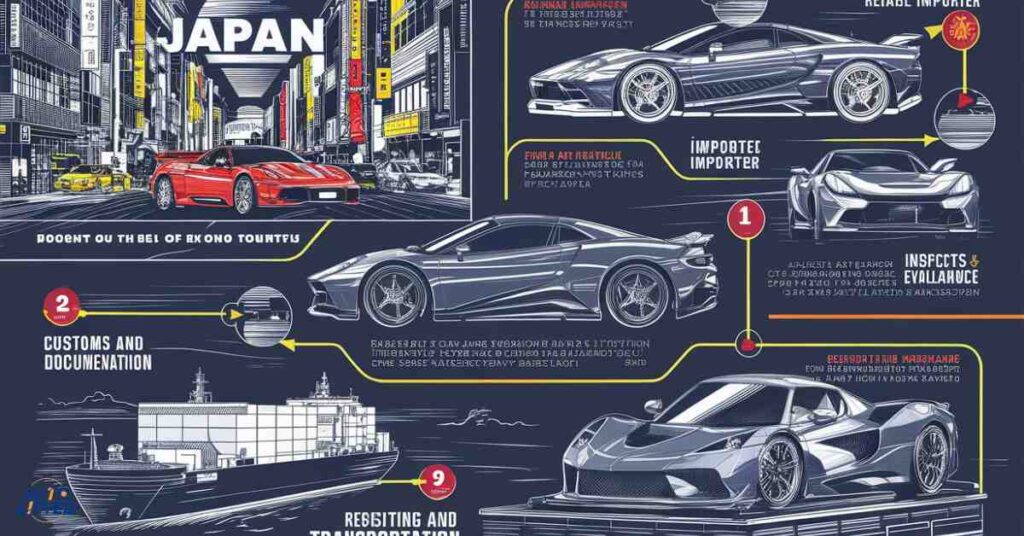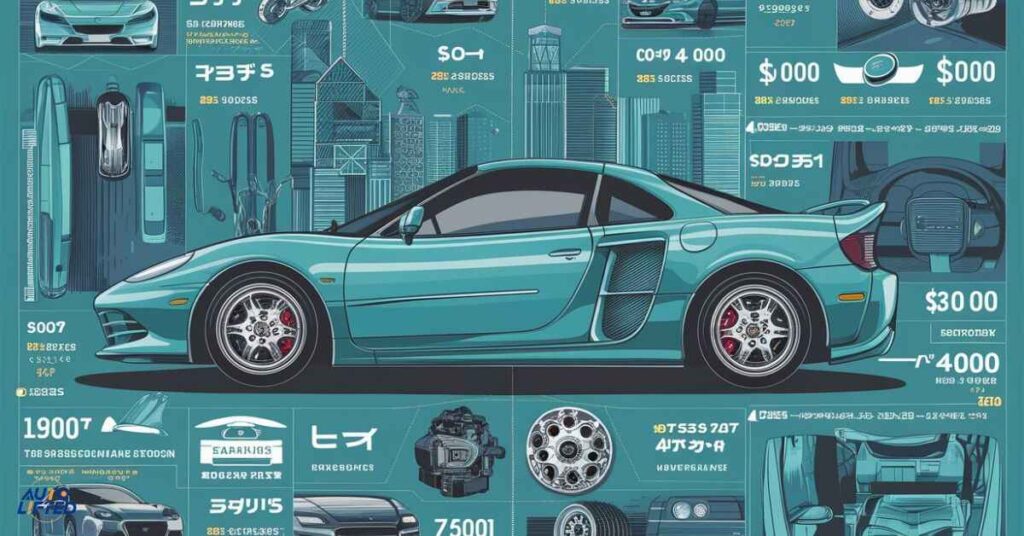Importing a car from Japan takes time and involves multiple steps. Finding the right car can take months. Money transfers and paperwork take a few weeks.
Shipping the car usually takes 4 to 6 weeks. Once it arrives, collection and preparation take additional time. Finally, registration can take a few days to weeks. Overall, the process can take several months from start to finish. Patience and careful planning are essential.
Time and Process for Importing a Car from Japan

Finding and Purchasing the Right Car
Importing a car from Japan starts with identifying the perfect vehicle. This step can take anywhere from a few days to several months, depending on your specific requirements and the availability of suitable cars. Patience is crucial as you wait for a car that matches your criteria and falls within your budget.
Read This Blog:
Who Buys Car Batteries For Cash
Financial Transactions
After finding the right car, the next step is transferring money to complete the purchase. International money transfers can take a few days to process. Ensure all financial transactions are handled securely to avoid delays.
Completing the Paperwork
Proper documentation is vital for importing a vehicle. This includes the bill of sale, export certificate, and other necessary forms. Completing and verifying paperwork can take a few weeks, as accuracy is essential to avoid complications during shipping and registration.
Shipping Process
Shipping a car from Japan to the United States typically takes 4 to 6 weeks. The duration depends on the shipping method and destination port. Factors like shipping schedules, customs clearance, and potential delays at sea can affect this timeline.
Post-Arrival Procedures: Collection, Preparation, and Testing
Once your car arrives in the US, it must go through customs clearance, which can take a few days to a week. After clearing customs, the vehicle needs to be collected, inspected, and prepared for use. This includes any necessary modifications to meet US standards and thorough testing to ensure roadworthiness.
Vehicle Registration
The final step is registering the car in your state. This process varies depending on local regulations and typically includes a vehicle inspection, emissions testing, and submission of all required documentation. Registration can take a few days to a few weeks.
Finding and Purchasing the Right Car

Finding and purchasing the right car from Japan is the first step in the import process. Here’s a breakdown of what it entails:
Research
Start by researching the type of car you want. Consider factors like make, model, year, and specifications. Look into various sources such as Japanese car auction sites, dealerships, and importers specializing in Japanese vehicles.
Setting a Budget
Determine your budget, including the purchase price, shipping costs, import duties, and any modifications needed to meet US standards. Keep in mind that cars from Japan can vary widely in price.
Monitoring Listings
Regularly check listings on auction sites and dealerships. You might need to wait several weeks or months for the right car to appear. Patience and persistence are key during this phase.
Bidding and Negotiation
Once you find a car that meets your criteria, you may need to bid on it if it’s at an auction. Be prepared to negotiate the price with the seller or dealer. Ensure all terms of the sale are clear and agreed upon.
Vehicle Inspection
Before finalizing the purchase, arrange for a pre-purchase inspection. Many Japanese auction sites offer inspection reports, but you can also hire a third-party inspection service. This step ensures the car’s condition matches the description and there are no hidden issues.
Securing the Purchase
After agreeing on a price and completing the inspection, proceed with the purchase. This involves signing a sales agreement and initiating a money transfer. Make sure all financial transactions are conducted securely to avoid any potential fraud.
Documentation
Ensure you receive all necessary documents, including the bill of sale, export certificate, and any maintenance records. These documents are crucial for the import process and future registration in the US.
The process of finding and purchasing the right car from Japan can take from a few weeks to several months, depending on how specific your requirements are and the availability of suitable vehicles. Being thorough in your research and patient in your search will help ensure you find the best car for your needs.
Also Read This Blog:
How Long Does It Take To Put Tint On A Car
Financial Transactions
Initial Payment
Once you’ve agreed on a price for the car, you’ll need to make an initial payment to secure the purchase. This is often a deposit and can range from a small percentage to the full price, depending on the seller’s terms.
International Money Transfer
Transferring money internationally can take a few days to process. Use a reliable and secure method, such as a bank transfer or a reputable payment service. Ensure you understand the fees involved and the current exchange rates, as these can impact the total cost.
Payment Methods
Bank Wire Transfer: Directly transferring funds from your bank account to the seller’s account.
Escrow Services: Holding the funds in a third-party account until the transaction is completed to ensure both parties fulfill their obligations.
Credit Cards or PayPal: Less common but might be an option with some sellers. Be aware of transaction fees and potential currency conversion costs.
Payment Confirmation
After sending the payment, confirm that the seller has received it. Obtain a receipt or confirmation of payment for your records. This is crucial for tracking the transaction and resolving any disputes that may arise.
Final Payment
If you initially made a deposit, you’ll need to arrange for the final payment once the car is ready for shipment. Ensure all terms of the sale are met before completing the payment.
Transaction Security
To protect yourself from fraud, follow these guidelines:
Verify Seller Credibility: Research the seller’s reputation and read reviews from previous buyers.
Use Secure Payment Methods: Avoid methods that offer little recourse if something goes wrong, such as cash payments.
Keep Records: Maintain detailed records of all communications, payments, and receipts.
Currency Exchange
Since you’re dealing with Japanese yen (JPY) and US dollars (USD), be mindful of exchange rates. Fluctuations can affect the total cost of the car. Some payment services offer fixed exchange rates for a short period, which can help you avoid unexpected increases.
Handling financial transactions carefully ensures a smooth purchase process and helps avoid delays. Proper planning and secure payment methods are essential for a successful car import from Japan.
Completing the Paperwork

Completing the Paperwork
Completing the necessary paperwork is a crucial aspect of importing a car from Japan. Here’s what you need to know:
Export Certificate
The seller in Japan will provide you with an export certificate, also known as the de-registration certificate. This document proves that the car is no longer registered in Japan and can be exported. Ensure the export certificate is accurate and matches the vehicle’s details.
Bill of Sale
A bill of sale is a legal document that outlines the terms and conditions of the sale. It includes details such as the purchase price, vehicle identification number (VIN), seller and buyer information, and any warranties or guarantees. Both parties must sign the bill of sale.
Import Declaration Form
You’ll need to fill out an import declaration form for customs purposes when bringing the car into the United States. This form provides information about the vehicle, its origin, and its value. Customs officials use this information to assess import duties and taxes.
Vehicle Inspection Report
Before shipping the car, consider arranging for a vehicle inspection report. This report details the condition of the vehicle and any existing damage. While not always required, having an inspection report can provide peace of mind and help resolve any disputes with the seller.
Shipping Documents
Work with your chosen shipping company to ensure all shipping documents are in order. This may include a booking confirmation, bill of lading, and insurance certificate. These documents are essential for tracking the shipment and ensuring its safe arrival.
Import Duty and Tax Forms
You may need to fill out additional forms related to import duties and taxes. The amount you owe depends on factors such as the value of the car and its country of origin. Familiarize yourself with the relevant regulations and consult with customs officials or a customs broker if needed.
Vehicle Title and Registration
Once the car arrives in the United States, you’ll need to apply for a vehicle title and register it in your state. This process involves submitting the necessary paperwork, paying registration fees, and obtaining license plates. Each state has its own requirements, so research the specific procedures for your location.
Compliance Certificates
Depending on the vehicle’s age and specifications, you may need to obtain compliance certificates to ensure it meets US safety and emissions standards. This may involve modifications or adjustments to the car before it can be legally driven on US roads.
Keep Copies
Make copies of all paperwork for your records. Having duplicates of important documents can be invaluable in case of loss or disputes. Store them in a safe place where you can easily access them when needed.
Consult Professionals
If you’re unsure about any aspect of the paperwork process, consider consulting with professionals such as customs brokers or import specialists. They can provide guidance and assistance to ensure everything is completed correctly and efficiently.
Completing the paperwork accurately and thoroughly is essential for a successful car import from Japan. By staying organized and following the necessary procedures, you can navigate the paperwork process with confidence and ease.
Terminology for Japanese Import Cars

Understanding the terminology associated with Japanese import cars can help navigate the import process and communicate effectively with sellers and professionals. Here are some key terms to know:
JDM (Japanese Domestic Market)
JDM refers to vehicles that were originally manufactured for sale in the Japanese domestic market. These cars often feature unique specifications and configurations tailored to Japanese regulations and consumer preferences.
Grey Import
A grey import is a vehicle imported from another country without the manufacturer’s official authorization. While grey imports can offer access to unique models not available domestically, they may not comply with local safety and emissions standards.
Kei Car
Kei cars are small, lightweight vehicles designed to comply with Japan’s strict regulations for compact cars. They typically have small-displacement engines and compact dimensions, making them popular for city driving in Japan.
GTR
GTR stands for Gran Turismo Racing and is commonly associated with high-performance models produced by Nissan. The Nissan Skyline GTR and Nissan GT-R are iconic examples known for their racing heritage and advanced technology.
Turbocharged
Turbocharging is a method of forced induction that increases an engine’s power output by compressing air before it enters the combustion chamber. Many Japanese import cars, especially performance models, feature turbocharged engines for enhanced performance.
VTEC
Variable Valve Timing and Lift Electronic Control (VTEC) is a technology developed by Honda that adjusts valve timing and lift to optimize engine performance at different RPM ranges. VTEC engines are known for their high-revving capabilities and efficient power delivery.
Rotary Engine
A rotary engine, also known as a Wankel engine, is a type of internal combustion engine that uses a rotating triangular rotor instead of conventional pistons. Mazda is well-known for producing rotary-powered cars like the RX-7 and RX-8.
Four-Wheel Drive (4WD) vs. All-Wheel Drive (AWD)
Four-wheel drive (4WD) and all-wheel drive (AWD) systems distribute power to all four wheels of a vehicle for improved traction and stability. While 4WD is typically selectable and optimized for off-road use, AWD systems continuously vary power distribution for enhanced performance and handling on various surfaces.
OEM vs. Aftermarket Parts
OEM (Original Equipment Manufacturer) parts are components produced by the vehicle’s manufacturer, ensuring compatibility and quality. Aftermarket parts are produced by third-party manufacturers and may offer customization options but can vary in quality and fitment.
Right-Hand Drive (RHD)
Right-hand drive vehicles have their steering wheel and driver’s controls on the right side of the car, as opposed to left-hand drive (LHD) vehicles commonly used in North America and Europe. Many Japanese import cars are right-hand drive, reflecting Japan’s traffic regulations.
Understanding these terms will enhance your knowledge of Japanese import cars and facilitate discussions with sellers, importers, and automotive professionals. Whether you’re a enthusiast or a prospective buyer, familiarizing yourself with these terms will help you make informed decisions throughout the import process.
Maintenance Costs for Japanese Cars

Maintaining a Japanese car typically comes with several advantages, including reliability and affordability. Here’s what to consider regarding maintenance costs:
Reliability
Japanese cars are renowned for their reliability and durability. With proper maintenance and care, they can often outlast vehicles from other manufacturers. This reliability reduces the frequency of unexpected repairs and contributes to lower overall maintenance costs over the vehicle’s lifespan.
Affordable Parts
One of the main reasons Japanese cars tend to have lower maintenance costs is the availability of affordable parts. The widespread popularity of Japanese brands means that genuine and aftermarket parts are readily available, leading to competitive pricing. This accessibility makes routine maintenance and repairs more affordable for owners.
DIY Maintenance
Many Japanese cars are designed with ease of maintenance in mind. Simple maintenance tasks such as oil changes, brake pad replacements, and fluid checks can often be performed by owners with basic tools and mechanical knowledge. DIY maintenance helps save on labor costs associated with professional servicing.
Fuel Efficiency
Japanese cars are known for their fuel efficiency, which can result in lower fuel expenses over time. Efficient engines and advanced technologies, such as hybrid and electric powertrains, help reduce fuel consumption and lessen the financial burden of operating the vehicle.
Manufacturer Support
Japanese car manufacturers typically offer robust support networks, including authorized dealerships and service centers. Access to manufacturer-trained technicians and specialized diagnostic equipment ensures quality service and accurate repairs, further reducing the risk of costly maintenance issues.
Long-Term Value
Japanese cars often maintain their resale value well, especially models with strong reputations for reliability and longevity. Investing in a Japanese car with a good resale value can mitigate depreciation costs and provide financial security in the long run.
Special Considerations
While Japanese cars generally have lower maintenance costs, there are factors to consider. High-performance models or vehicles with complex technology may require specialized maintenance and parts, which can be more expensive. Additionally, imported Japanese cars may have limited availability of certain parts or require longer wait times for repairs.
Overall, Japanese cars offer a compelling combination of reliability, affordability, and longevity, resulting in lower maintenance costs compared to many other vehicles. By prioritizing regular maintenance and selecting a reputable model, owners can enjoy years of dependable performance without breaking the bank on upkeep.
Frequently asked Question
How long does it take for a vehicle to arrive from Japan?
It typically takes 4 to 6 weeks for a car to arrive from Japan to its destination, depending on factors like shipping method and destination port.
How long does importing a car from Japan take?
Importing a car from Japan involves multiple steps and can take several months, including finding the right car, completing paperwork, shipping, and post-arrival procedures.
How much does it cost to import a car from Japan?
The cost of importing a car from Japan depends on various factors such as the vehicle’s value, shipping method, import duties, taxes, and any additional fees or modifications required for compliance with local regulations.
Why are cars in Japan so cheap?
Cars in Japan can be relatively cheaper due to factors like lower depreciation rates, efficient manufacturing processes, high competition among automakers, and a well-maintained second-hand car market.
Is it OK to buy an imported car from Japan?
Buying an imported car from Japan can be a viable option, considering the country’s reputation for producing reliable vehicles. However, it’s essential to research thoroughly, ensure compliance with local regulations, and verify the car’s condition and history before making a purchase.
Conclusion
Importing a car from Japan is a process that demands both patience and careful planning. From the initial search for the right vehicle to the completion of paperwork, shipping, and post-arrival procedures, the entire process can take several months.
Firstly, finding the perfect car that meets your criteria and budget can take anywhere from a few days to several months, depending on availability and specificity of requirements.
Secondly, completing the necessary paperwork, including financial transactions, export certificates, and import declarations, can take several weeks, ensuring compliance with regulations and securing the purchase.
Lastly, the shipping process itself typically takes between 4 to 6 weeks, depending on factors such as shipping method and destination port, followed by additional time for customs clearance, collection, preparation, and registration upon arrival.
Therefore, while the exact timeline may vary, it’s essential to approach the import process with realistic expectations and thorough attention to detail to ensure a smooth and successful experience.







